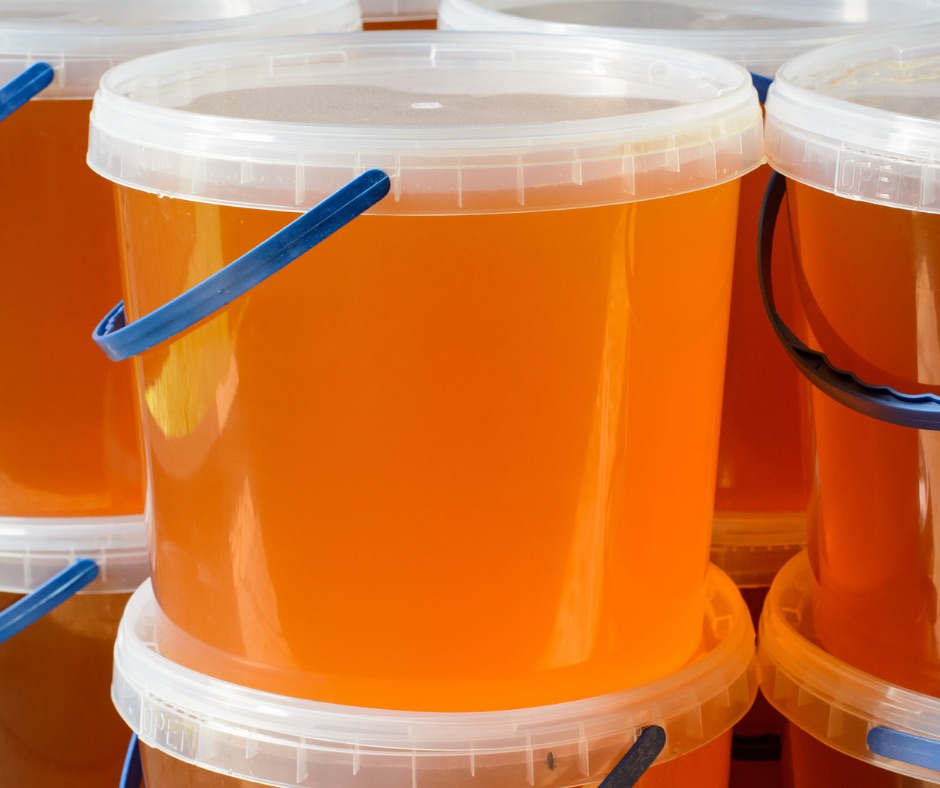Do you have crystallized honey in a plastic bottle?
Well, realize that it isn’t a catastrophe, and with the straightforward method we’ll be showing you in this article, you can effortlessly reclaim its liquidy nature.

How Do You Soften Honey In A Plastic Container?
It’s a common scenario – you reach for your honey to find it’s transformed from a delightful syrupy treat into a stubborn solid block.
Don’t worry, though.
Your honey hasn’t gone bad, it’s just crystallized, which is a natural process.
But how do we bring it back to its smooth texture?
Here are two practical and easy methods.
For the first approach, begin by placing your sealed honey container into a heatproof bowl or similar vessel.
Pour freshly boiled water from your kettle into the bowl until it reaches mid-way or three-quarters of the height of the honey container (don’t worry about your plastic container melting, it won’t — unless you have your honey stored in one of those cheap plastic bottles which is less than likely for preservation of quality purposes).
Allow it to rest there, giving an occasional stir until you notice that the honey has regained its softness.
Or if you prefer not to use boiling water, there’s a slightly slower but no less effective method.
Simply fill up a pot with hot tap water – as hot as your faucet can go without any cold water mixed in.
Stand your plastic honey bottle upright in this heated bath and leave it be until the water cools down.
If the honey remains crystallized after this process, just repeat the steps until your beloved sweet nectar returns to its pourable form.
Can I Microwave A Plastic Bottle Of Honey?
Technically you can. But should you?
That’s where we enter into the gray area.
The trouble with microwaving honey in plastic containers lies primarily in the heat sensitivity of plastic.
Subjecting these containers to high temperatures could lead to their deformation or even melting, potentially damaging your precious honey and the microwave itself.
Plastic containers also have a troubling habit of leaching chemicals when heated.
Those nasty little additives have no business meddling with your sweet treat and can impact both its quality and safety.
One more thing! An underdiscussed fact about honey is that it’s home to an array of beneficial enzymes and antioxidants.
Unfortunately, your microwave doesn’t discriminate and zaps away some of these health-boosting nuggets along with heating your honey, leaving you with something less valuable in terms of both health benefits and flavor.
If you have your crystallized honey in a glass container however, you can heat it in the microwave with no problem.
Glass is naturally microwave-friendly, making it an excellent choice for this task.
Make sure you remove the lid before proceeding!
You don’t want any unexpected surprise explosions on your hands (or kitchen).
To avoid overheating, operate the microwave at 50% power only and heat the honey in 30-second intervals.
Give the honey a brisk stir after each interval to ensure even heating throughout.
Got a cooking thermometer handy?
This could be your secret weapon to prevent overheating; ideally, keep the temperature between 95°F to 104°F (35°C – 40°C) – just warm enough to restore that luscious liquidity without sacrificing any of its rich goodness.
Does Honey In A Plastic Bottle Go Bad?
Honey is an amazingly stable food with a seemingly eternal shelf life if preserved under ideal conditions.
It’s been reported to last for years, even decades, retaining its signature sweetness and aroma.
However, if your honey resides in a plastic bottle, you might need to keep an eye on it.
Here’s why…
Oxidation
Oxygen is the enemy of all things fresh. When honey comes into contact with air, light or heat, oxidation occurs leading to changes in color, flavor, and aroma over time. The once golden nectar can darken and lose its appetizing appeal. Plastic containers are no knights in shining armor when it comes to preventing this harmful reaction.
Crystallization
Don’t panic if your honey starts forming solid crystals! This natural process stems from sugars in the honey crystallizing over time; it doesn’t mean it’s become unfit for consumption and can be reversed by gentle heating. Still, crystallized honey can be hard to use and less appealing on your morning toast.
Interestingly, plastic bottles could speed up crystallization by letting moisture escape from the honey, making it more concentrated and more likely to crystalize.
Leaching
This chemical reality sees substances like BPA, phthalates or dyes leaching from the plastic container into your beloved honey. Exposure to high temperatures accelerates leaching that can affect the taste, smell and safety of your honey – not ideal for your tea or baking adventures!
With these factors in mind, you might want to reconsider your storage approach.
And that’s when you say hello to glass containers!
Glass is inert hence won’t react with honey or let oxygen, moisture or dodgy chemicals pass through as plastic would.
Moreover, glass containers maintain the natural color, flavor and aroma of your honey better than their plastic counterparts – something every true sweet tooth will appreciate!
What Effect Does Microwave Have On Honey?
To be frank, microwaving can actually significantly alter honey’s beneficial properties, taste and texture.
Honey is chock-full of enzymes, antioxidants and essential substances that are highly sensitive to high temperatures, as we have mentioned above.
The heat generated by the microwave can degrade these substances, significantly reducing the nutritional and medicinal value of honey.
This loss also compromises its characteristic aroma and flavor.
Besides this, microwaving alters honey’s texture and consistency.
The microwave induces boiling in the water content within honey.
This process generates foam and bubbles in the honey making it less smooth; instead more sticky and watery- a far cry from its original smooth nature. As some of this moisture evaporates due to boiling, the honey becomes concentrated; making it susceptible to crystallization.
The viscous nature of honey also means that microwaves cannot evenly distribute heat through it.
Some areas may become excessively hot leading to scorching or caramelization of sugars.
This uneven heating not only affects the taste but also changes the color and jeopardizes safety norms.
Using a microwave may seem convenient, but it isn’t ideal for your precious jar of honey.
Instead, opt for slow gentle warming methods such as a warm water bath or low-power stove heating to retain its natural qualities.

